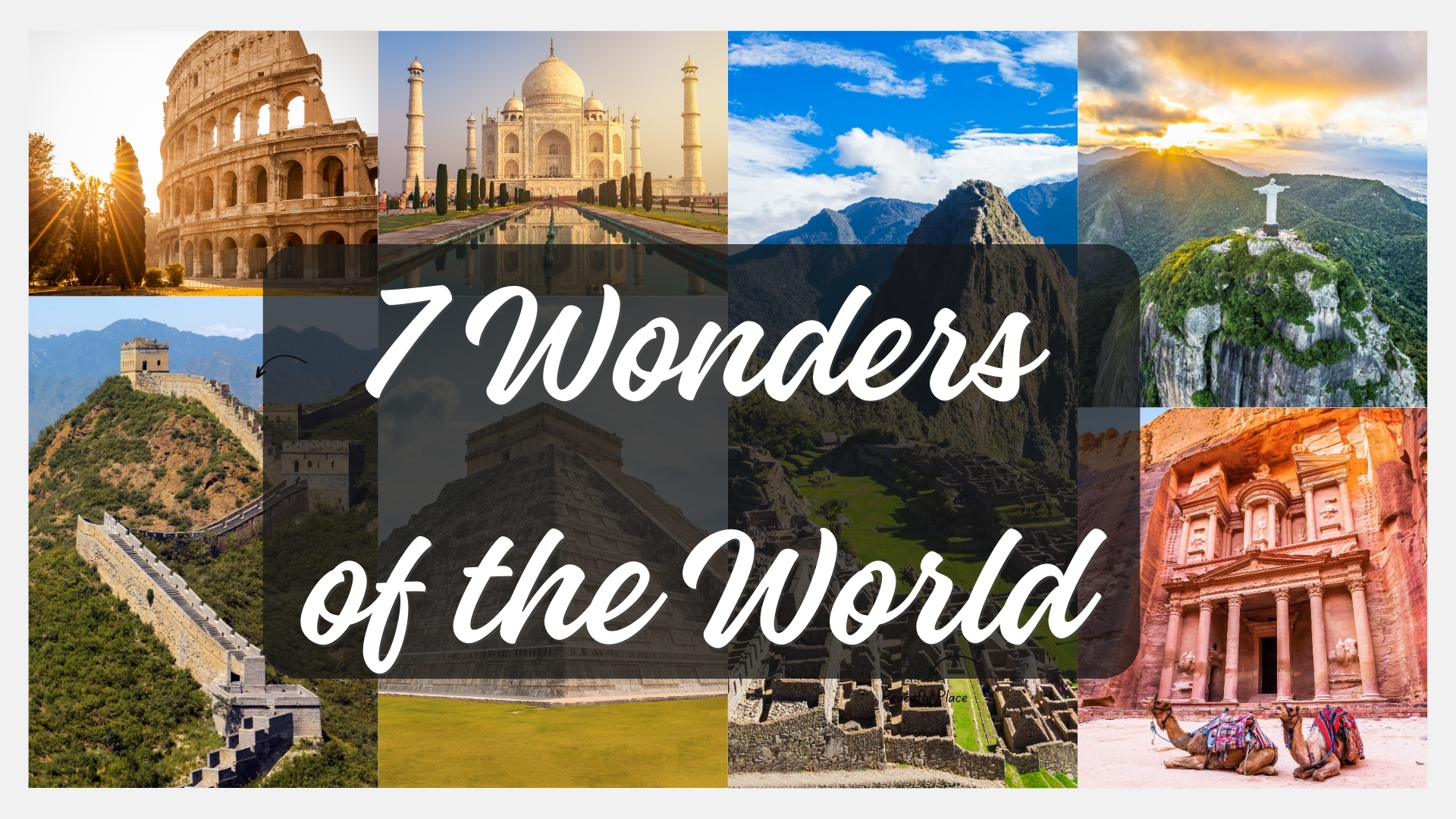7 Wonders of the World : The world is full of wonders, but there are some that transcend time, history, and even the pages of the travelogues. These are the magnificent Seven Wonders of the World. Join us on a journey through the ancient, the modern, and everything in between as we explore these spectacular marvels. From towering structures to iconic monuments, these wonders have captured the imagination of travelers, historians, and architects alike.
What Are the 7 Wonders of the World?
1. The Colosseum, Rome, Italy
The iconic Colosseum, an engineering marvel, stands tall in the heart of Rome, bearing witness to the city’s rich history. Built over eight years, from AD72 to AD80, this massive oval amphitheater was constructed using sand and stone, its impressive architecture a testament to the ingenuity of the ancient Romans. With a seating capacity of 80,000, the Colosseum was the largest amphitheater of its time, designed to accommodate a vast audience eager to witness a variety of spectacles, including gladiatorial games, theatrical performances, animal hunts, and even executions. Its expansive arena, surrounded by a circular ring of seating, was also known to host mock sea battles, with water being pumped in to create an authentic naval combat experience. Despite suffering damage from earthquakes and stone robbers over the centuries, the Colosseum remains an enduring symbol of Roman history and a popular tourist destination, attracting thousands of visitors each year. Its legacy and cultural significance make it an undeniable contender for a spot among the seven wonders of the world.
2. The Great Wall of China
Stretching across China’s historical northern boundary for thousands of miles, the Great Wall of China is an immense obstacle. Its origins can be traced back to the 7th century BCE when smaller walls were constructed as defense against nomadic attacks. In 220 BCE, Emperor Qin Shi Huang unified these walls into a single, formidable barrier, fortifying and expanding it to repel invaders from the north. Today, the wall is celebrated as one of the world’s seven wonders and, when considering all its sections, it spans an astonishing 13,171 miles.
3. The Taj Mahal, India
Situated in the city of Agra, India, lies the Taj Mahal, an impressive mausoleum made of white marble. It was built by the Mughal emperor Shah Jahan as a final resting place for his beloved wife, Mumtaz Mahal, who died in 1631 while giving birth. The complex spans 42 acres and includes a central marble tomb, as well as gardens, a mosque, a guest house, and a pool. The construction of this magnificent structure required the labor of 20,000 workers over a period of 22 years, with a total cost of 32 million rupees (equivalent to approximately US$827 million in today’s currency). The efforts invested in its creation have not been in vain, as the Taj Mahal now holds the distinction of being a UNESCO World Heritage Site and an integral part of India’s rich Mughal history.
Next Article: Where is Dubai? A City of Superlatives
4. Christ the Redeemer, Brazil
On the summit of Mount Corcovado, overlooking Rio de Janeiro, stands the towering and symbolic statue of Christ the Redeemer. This renowned monument, a significant representation of Brazil, reaches a height of 30 meters. Created by the Polish-French sculptor Paul Landowski during the 1920s, it was later finalized by Brazilian engineer Heitor da Silva Costa and French engineer Albert Caquot in 1931. Constructed from reinforced concrete covered with more than 6 million soapstone tiles, Christ the Redeemer stands as the largest Art Deco sculpture worldwide. Erected shortly after the conclusion of the First World War, this sculpture became a profound symbol of Christianity and optimism during a time of great adversity, making its inclusion in the list of today’s seven wonders unsurprising.
5. Machu Picchu, Peru
Machu Picchu is a 15th-century treasure that has been hidden for centuries, nestled high in the Andes mountains above the Peruvian Sacred Valley. This rare citadel is one of the few pre-Columbian ruins to be discovered nearly intact, showcasing remnants of former plazas, temples, agricultural terraces, and homes. Believed to have been built as an estate for Inca emperor Pachacuti around 1450, the citadel was crafted using polished drystone walls. The Incas abandoned the site a century later, and it remained hidden for millennia until American historian Hiram Bingham brought it to light in 1911. Its remarkable preservation has earned it recognition as one of the seven wonders.
6. Chichén Itzá, Mexico
Nestled in the heart of Mexico’s Yucatán state lies the ancient Mayan city of Chichen Itza, a testament to the ingenuity and craftsmanship of the pre-Columbian Itzá tribe. This historic site boasts a collection of majestic monuments and temples, with El Castillo, also known as the Temple of Kukulkan, being the crown jewel. This imposing step pyramid stands tall in the city’s center, serving as a dedication to the revered god Kukulkan. The temple’s design is a marvel in itself, featuring 365 steps, one for each day of the year. But what’s truly remarkable is the phenomenon that occurs during the spring and summer equinoxes, when the afternoon sun casts a triangular shadow down the pyramid’s north stairway, creating the illusion of a feathered serpent descending towards a stone snake head at the base. It’s no surprise that Chichen Itza is considered one of the seven wonders of the world, a true masterpiece of ancient civilization.
7. Petra, Jordan
Petra, an old city located in the south of Jordan, is famously called the ‘rose city’ due to its beautiful golden color. Its origins can be traced back to 312 BC. Situated in a secluded valley, this ancient city was established by the Arab Nabataeans, an advanced civilization that skillfully carved intricate architecture and intricate water systems into the surrounding rock formations. The Nabateans also turned Petra into a prosperous trading center, amassing great wealth and a thriving population before being devastated by earthquakes. For centuries, the existence of this city remained unknown to the Western world until it was uncovered in 1812 by Swiss adventurer Johann Ludwig Burckhardt. Poet and scholar John William Burgon, in the 19th century, described Petra as a city that is “half as old as time” and radiates a reddish color resembling a rose.
Conclusion
The Seven Wonders of the World have captivated the minds and hearts of people for centuries. They not only represent the peak of human achievement in their respective eras but also serve as a bridge between the past and present—a reminder of our shared history and the enduring human spirit to create and innovate.
Whether these wonders still stand today, lie in ruins, or exist only in the stories passed down through generations, they all contribute to the rich tapestry of human civilization. They challenge us to dream bigger, reach higher, and continue the quest for greatness.
As you reflect on these awe-inspiring works, remember that the world is replete with wonders waiting for you to explore. The most important thing is to keep the curiosity alive and the spirit of exploration kindled; for in every corner of the globe there lies a wonder to be discovered.
If you’re a history enthusiast, an avid traveler, or simply love a good story, the Seven Wonders of the World remain jewels in humanity’s crown, unbeaten paths that prompt us to look back and inspire us to move forward.
Disclaimer
All the information given in this blog is for your information only and is not used for commercial purposes. Although we do not ensure the accuracy and completeness of this information. We make every possible effort to do so, but there may still be some errors in it. We Will not be held liable in any way for possible damages arising from the use of the article.




